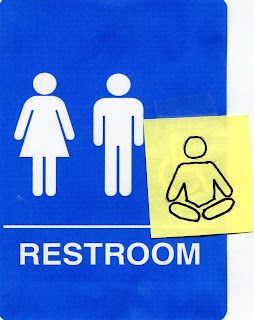Five Minutes in the John. Chapter Two: Easy as 1-2-3
Mindfulness is often spoken of as the heart of Buddhist meditation. It is not about Buddhism, but about paying attention. That’s what all meditation is, no matter what tradition or particular technique is used. - Jon Kabat-Zinn
When it comes to meditating I am a purist, keeping it simple and focused. No music. No guided imagery. Just me and my breath.
1. Sit some where...
This isn't real estate so location is really what ever works best for you and I have some suggestions.
A room, a corner in a room or a chair can be a meditation nest as long as you are comfortable and won’t be disturbed. You want a place without distractions, including cats, kids, phones, computers, books, magazines, iPads, radio, or television.
We often get chilled during meditation, so unless you live in the tropics you will want to have a blanket, shawl or jacket handy. A note pad and pen close by can also be a help for those thoughts that won't leave you in peace unless you write them down.
You may want to eventually create a sacred space that has pictures of saints or gurus, candles, incense and relics. If doing that encourages you, go for it. As Yoda says, the more work it is, the more chore it will be. Let what ever you do keep you interested and encouraged to sit. If things become to cumbersome or complicated we will put it off.
Hint: Lock the door.
Outside meditations can be wonderful, unless it’s buggy, your neighbors call 911 because they think you are unconscious, or you find yourself in the path of heavy equipment or kids on bikes. Search for peaceful mountaintops, deserted beaches, or a still spot amongst the trees.
Finally, there can be a “cush” for your “tush”. Some people prefer sitting on the floor. If you are comfortable that way, grab a pillow and go for it. Since I have gotten older and more creaky, I prefer a chair. Sitting somewhere is the most important part. Where, or on what, is not important as long as you are comfortable and undisturbed.
The round pillow is called a zafu and the square one a zabuton. They are made especially for meditation practice. A couch cushion, bed pillow or the dog bed can also work. Place it in the location of your choice.
So now we have our location for this mediation. Be open to tweaking this until you find a place that works best for you. Some instructions ask us to sit in the same place, at the same time each day. Doing that will develop a conditioned response that can support deeper meditation. If it fits into your way of life, do that. However, if you have a choice between catching random moments in random places or not meditating, choose meditation every time.
I am often asked if it is okay to meditate lying down or in bed. Everything is okay, but often when we lay down we go to sleep. That is fine if you are tired, but not if you want to meditate. Meditation is a heightened sense of awareness, not unconsciousness. If you tend to fall asleep when you meditate, sit in a chair with your feet on the floor. That should help solve the problem.
The bottom line is that it is most important to do it. As my friend said: put your tush on the cush. Wherever you end up, be comfortable, quiet and let it support you in your budding practice.
2. Close. Your. Eyes.
Closed eyes help to eliminate distractions and focus our attention inward. It is not a rule, but a suggestion. If closed eyes are uncomfortable, or if you like walking meditations and tend to bounce off trees, open your eyes with a soft focus as if you are looking past, rather than at, objects. Try not to look around at the dust balls in the corner and jump up to clean. The ego is uncomfortable looking inward, so the mind will be expert at creating distractions to get us moving again. Don't fall for that old trick. Gently, kindly, acknowledge the dust bunny and agree to tend to it after you sit. Then come back to your breath. That is all we do, whatever kind of distractions the mind generates. Acknowledge, gently come back to awareness of your breath. You might do that 50 times, and it is ok. You are not doing it wrong, and you are not bad at this. This is the normal process and why it is called a practice.
3. Breathe. Inhale and exhale.
You do it normally or you wouldn’t be reading this. Nothing fancy, just breathe at a comfortable pace for your body. Breathe in, breathe out, relax, and pay attention. Notice how breathing feels as air passes your nostrils and your lungs expand and contract.
If you want to get fancy, counting breaths is a popular way to focus attention. You can breathe in on 1, out on 2 or count one complete breath as 1. Often people will count to 10 and then start again. See how many rounds of 10 you can manage before you lose attention. If that seems like too much, just breath normally.
That’s it. 1-2-3!
© 2022 Hillary Gauvreau Oat



Comments
Post a Comment